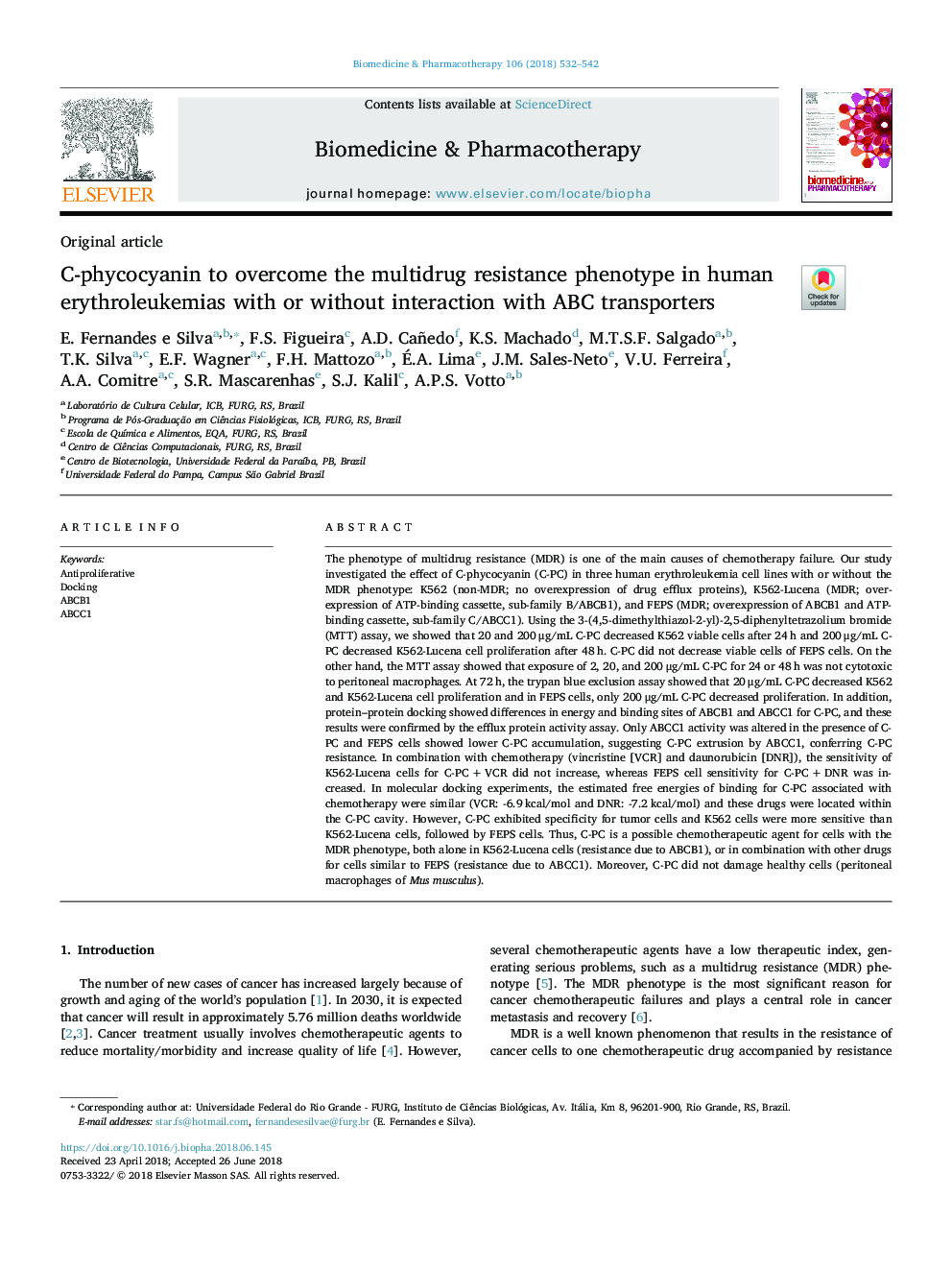| Article ID | Journal | Published Year | Pages | File Type |
|---|---|---|---|---|
| 8525324 | Biomedicine & Pharmacotherapy | 2018 | 11 Pages |
Abstract
The phenotype of multidrug resistance (MDR) is one of the main causes of chemotherapy failure. Our study investigated the effect of C-phycocyanin (C-PC) in three human erythroleukemia cell lines with or without the MDR phenotype: K562 (non-MDR; no overexpression of drug efflux proteins), K562-Lucena (MDR; overexpression of ATP-binding cassette, sub-family B/ABCB1), and FEPS (MDR; overexpression of ABCB1 and ATP-binding cassette, sub-family C/ABCC1). Using the 3-(4,5-dimethylthiazol-2-yl)-2,5-diphenyltetrazolium bromide (MTT) assay, we showed that 20 and 200â¯Î¼g/mL C-PC decreased K562 viable cells after 24â¯h and 200â¯Î¼g/mL C-PC decreased K562-Lucena cell proliferation after 48â¯h. C-PC did not decrease viable cells of FEPS cells. On the other hand, the MTT assay showed that exposure of 2, 20, and 200â¯Î¼g/mL C-PC for 24 or 48â¯h was not cytotoxic to peritoneal macrophages. At 72â¯h, the trypan blue exclusion assay showed that 20â¯Î¼g/mL C-PC decreased K562 and K562-Lucena cell proliferation and in FEPS cells, only 200â¯Î¼g/mL C-PC decreased proliferation. In addition, protein-protein docking showed differences in energy and binding sites of ABCB1 and ABCC1 for C-PC, and these results were confirmed by the efflux protein activity assay. Only ABCC1 activity was altered in the presence of C-PC and FEPS cells showed lower C-PC accumulation, suggesting C-PC extrusion by ABCC1, conferring C-PC resistance. In combination with chemotherapy (vincristine [VCR] and daunorubicin [DNR]), the sensitivity of K562-Lucena cells for C-PCâ¯+â¯VCR did not increase, whereas FEPS cell sensitivity for C-PCâ¯+â¯DNR was increased. In molecular docking experiments, the estimated free energies of binding for C-PC associated with chemotherapy were similar (VCR: -6.9â¯kcal/mol and DNR: -7.2â¯kcal/mol) and these drugs were located within the C-PC cavity. However, C-PC exhibited specificity for tumor cells and K562 cells were more sensitive than K562-Lucena cells, followed by FEPS cells. Thus, C-PC is a possible chemotherapeutic agent for cells with the MDR phenotype, both alone in K562-Lucena cells (resistance due to ABCB1), or in combination with other drugs for cells similar to FEPS (resistance due to ABCC1). Moreover, C-PC did not damage healthy cells (peritoneal macrophages of Mus musculus).
Keywords
Related Topics
Health Sciences
Medicine and Dentistry
Oncology
Authors
E. Fernandes e Silva, F.S. Figueira, A.D. Cañedo, K.S. Machado, M.T.S.F. Salgado, T.K. Silva, E.F. Wagner, F.H. Mattozo, Ã.A. Lima, J.M. Sales-Neto, V.U. Ferreira, A.A. Comitre, S.R. Mascarenhas, S.J. Kalil, A.P.S. Votto,
